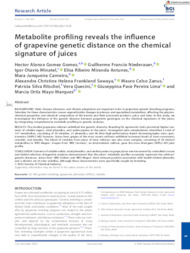Metabolite profiling reveals the influence of grapevine genetic distance on the chemical signature of juices.
Metabolite profiling reveals the influence of grapevine genetic distance on the chemical signature of juices.
Author(s): GOMEZ, H. A. G.; NIEDERAUER, G. F.; MINATEL, I. O.; ANTUNES, E. R. M.; CARNEIRO, M. J.; SAWAYA, A. C. H. F.; ZANUS, M. C.; RITSCHEL, P. S.; QUECINI, V.; LIMA, G. P. P.; MARQUES, M. O. M.
Summary: Yield, disease tolerance, and climate adaptation are important traits in grapevine genetic breeding programs. Selection for these characteristics cause unpredictable changes in primary and specialized metabolism, affecting the physicochemical properties and chemical composition of the berries and their processed products, juice and wine. In this study, we investigated the influence of the genetic distance between grapevine genotypes on the chemical signatures of the juices, by integrating comprehensive metabolic profiling to genetic analyses. Results: The studied grapevine cultivars exhibited low genetic diversity. Breeding for agronomic traits promoted higher contents of soluble sugars, total phenolics, and anthocyanins in the juices. Untargeted juice metabolomics identified a total of 147 metabolites, consisting of 30 volatiles, 21 phenolics, and 96 UHPLC?MS features. Juices from grapes of the most recent cultivars exhibited increased levels of trans?resveratrol, catechin, and luteolin. The blend of volatiles from juices of later cultivars was also more complex, consisting of 29 distinct metabolites in ‘BRS Magna. Grapes from ‘BRS Carmem’, an intermediate cultivar, gave the most divergent UHPLC?MS juice profile. Conclusion: Contents of soluble solids, total phenolics and anthocyanins in grape juices were increased by controlled crosses and hybrid selection. Integrative analyses demonstrated that the juices metabolic profiles accurately represent the cultivars genetic distances. Juices from ‘BRS Violeta’ and ‘BRS Magna’ show relevant positive association with health?related phenolics and a distinct set of odor volatiles, although these characteristics were not aimed at by breeding.
Publication year: 2023
Types of publication: Journal article
Unit: Embrapa Grape & Wine
Observation
Some of Embrapa's publications are published as ePub files. To read them, use or download one of the following free software options to your computer or mobile device. Android: Google Play Books; IOS: iBooks; Windows and Linux: Calibre.
Access other publications
Access the Agricultural Research Database (BDPA) to consult Embrapa's full library collection and records.
Visit Embrapa Bookstore to purchase books and other publications sold by Embrapa.

